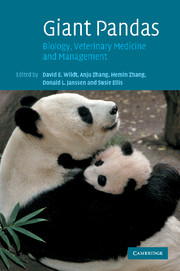Book contents
- Frontmatter
- Contents
- List of contributors
- Foreword
- Acknowledgements
- 1 The giant panda as a social, biological and conservation phenomenon
- 2 The Giant Panda Biomedical Survey: how it began and the value of people working together across cultures and disciplines
- 3 Factors limiting reproductive success in the giant panda as revealed by a Biomedical Survey
- 4 Significant medical issues and biological reference values for giant pandas from the Biomedical Survey
- 5 Life histories and behavioural traits as predictors of breeding status
- 6 Nutrition and dietary husbandry
- 7 Male reproductive biology in giant pandas in breeding programmes in China
- 8 Endocrinology of the giant panda and application of hormone technology to species management
- 9 The value and significance of vaginal cytology
- 10 Parentage assessment among captive giant pandas in China
- 11 The science of behavioural management: creating biologically relevant living environments in captivity
- 12 Evaluating stress and well-being in the giant panda: a system for monitoring
- 13 The neonatal giant panda: hand-rearing and medical management
- 14 Consequences of early rearing on socialization and social competence of the giant panda
- 15 Medical management of captive adult and geriatric giant pandas
- 16 Diseases and pathology of giant pandas
- 17 Ultrasonography to assess and enhance health and reproduction in the giant panda
- 18 Gastrointestinal endoscopy in the giant panda
- 19 Historical perspective of breeding giant pandas ex situ in China and high priorities for the future
- 20 Role and efficiency of artificial insemination and genome resource banking
- 21 Analysis of demographic and genetic trends for developing a captive breeding masterplan for the giant panda
- 22 Partnerships and capacity building for securing giant pandas ex situ and in situ: how zoos are contributing to conservation
- Index
- Plate Section
- References
3 - Factors limiting reproductive success in the giant panda as revealed by a Biomedical Survey
Published online by Cambridge University Press: 09 August 2009
- Frontmatter
- Contents
- List of contributors
- Foreword
- Acknowledgements
- 1 The giant panda as a social, biological and conservation phenomenon
- 2 The Giant Panda Biomedical Survey: how it began and the value of people working together across cultures and disciplines
- 3 Factors limiting reproductive success in the giant panda as revealed by a Biomedical Survey
- 4 Significant medical issues and biological reference values for giant pandas from the Biomedical Survey
- 5 Life histories and behavioural traits as predictors of breeding status
- 6 Nutrition and dietary husbandry
- 7 Male reproductive biology in giant pandas in breeding programmes in China
- 8 Endocrinology of the giant panda and application of hormone technology to species management
- 9 The value and significance of vaginal cytology
- 10 Parentage assessment among captive giant pandas in China
- 11 The science of behavioural management: creating biologically relevant living environments in captivity
- 12 Evaluating stress and well-being in the giant panda: a system for monitoring
- 13 The neonatal giant panda: hand-rearing and medical management
- 14 Consequences of early rearing on socialization and social competence of the giant panda
- 15 Medical management of captive adult and geriatric giant pandas
- 16 Diseases and pathology of giant pandas
- 17 Ultrasonography to assess and enhance health and reproduction in the giant panda
- 18 Gastrointestinal endoscopy in the giant panda
- 19 Historical perspective of breeding giant pandas ex situ in China and high priorities for the future
- 20 Role and efficiency of artificial insemination and genome resource banking
- 21 Analysis of demographic and genetic trends for developing a captive breeding masterplan for the giant panda
- 22 Partnerships and capacity building for securing giant pandas ex situ and in situ: how zoos are contributing to conservation
- Index
- Plate Section
- References
Summary
INTRODUCTION
There is surprisingly little published information about giant panda biology, especially in the life sciences. This poor quantity (and quality) of data has been due primarily to too few individual animals available for study and a traditional hands-off policy towards hands-on research in such a rare and high-profile species. However, recent changes (see Chapter 2) have created important, new opportunities for giant panda investigations. People responsible for ensuring that the species survives now realise that giant pandas living in zoos and breeding centres are a valuable research resource (see Chapter 1). It also has been recognised that this population must be intensively managed if it is truly to support giant pandas that are surviving precariously in nature. The intended result will be an ever-increasing amount of new, scholarly information and sufficient panda numbers to continue educating the public, helping to raise conservation funding, serving as a hedge against extinction, and even as a source of animals for potential reintroductions. However, these laudable goals can only be achieved by first understanding and then rigorously managing the captive population so that it becomes demographically and genetically stable. This, in fact, has become the mantra of Chinese managers of the ex situ population: ‘to develop a self-sustaining, captive population of giant pandas that will assist supporting a long-term, viable population in the wild’ (see Chapter 2).
- Type
- Chapter
- Information
- Giant PandasBiology, Veterinary Medicine and Management, pp. 37 - 58Publisher: Cambridge University PressPrint publication year: 2006
References
- 1
- Cited by



